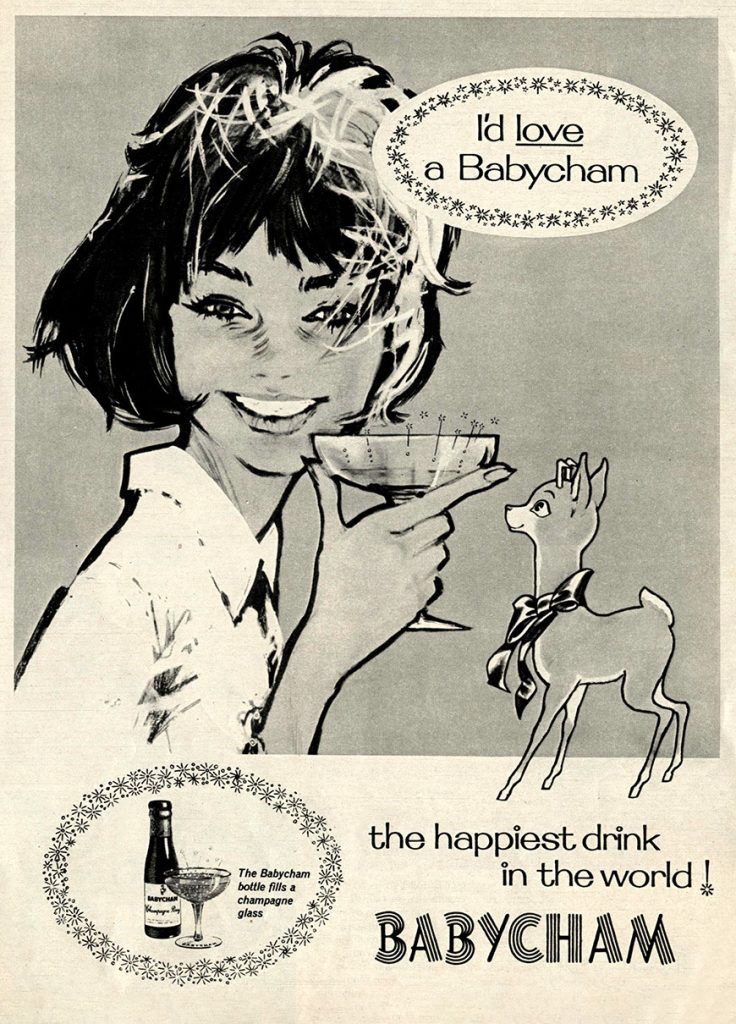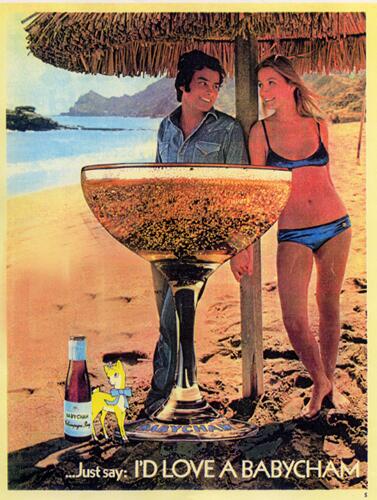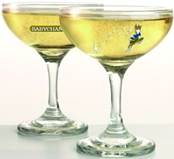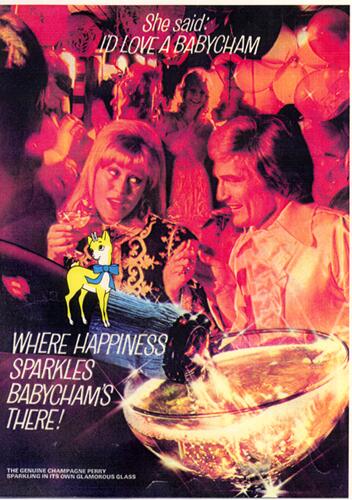In the early ‘50s, change was in the air. Television was finding its way into more living rooms across the UK. Shopping centres were looming large over local greengrocers and butchers. Holiday camps were all the rage, with Pontins, Warner and Butlin’s welcoming suitcase-carrying families. And the sports car was becoming democratised, with new models including the Austin-Healey 100, Sunbeam Alpine and Triumph TR2.
All of this and much more besides would have been the talk of the drinkers in pubs up and down the country. But there was another significant change playing out in those same public houses: women were asking friends if they’d tried the new alcoholic drink called Babycham.

The sparkling perry would become a sensation. Up until 1953, and the launch of Babycham, women had made do with sipping a port and lemon or milk stout. Now there was a drink aimed at them, and whether walking around the corner to their local or taking a drive to a rose-covered country pub, when asked what they’d like to have millions of drinkers up and down the country would tell the bartender, “I’d love a Babycham!”.
The Babycham story begins in the 1940s when Herbert Showering, a brewer from Shepton Mallet in Somerset, identified a gap in the market for a drink aimed solely at women, at a time when it was considered taboo for a lady to enter a pub or, heaven forbid, order a drink at the bar. Yet it was down to practical considerations.
At the time of Showering’s eureka moment, the Showerings were only producing apple cider, but were struck by the surplus of pears when visiting local orchards. Despite being produced for generations, perry (pear cider) wasn’t commercially viable, thanks to the difficulty in harvesting and the pear’s short shelf life.
Herbert enlisted the help of his brother Francis, a trained chemist, who devised a way of using ready-made pair juice concentrate from Wasser pears sourced from Switzerland. The brothers propagated the tree, grafted it with another perry pear variant, and planted thousands of acres of orchards in local farms.
Originally called ‘Champagne De La Pois’, the drink was served in small bottles and entered into competitions at agricultural shows, where it became known as the ‘Baby Champ’. This was shortened to Babycham following an unsuccessful meeting with an advertising agency to come up with a brand name. Towards the end of the discussion, the transport manager asked the brothers, “Where would you like the ‘baby cham’ sent to?”. The rest is history.
The Babycham trademark was registered in the ‘cider and perry’ class in 1950, and the brothers began selling the drink in the Bristol area.




As the rock biographer Philip Norman points out in this BBC article from 2013, “Babycham was the first drink a woman could order in a bar without feeling a tart or a crone.”
Then, in many quarters a woman’s role was to stay at home to raise the children – only the family allowance was paid directly to the mother. As revealed by this Motor Sport report on the 1953 Earls Court Motor Show, women were viewed very differently.
Bill Boddy writes: “Thoughts of long journeys across Europe on sun-drenched summer days to shimmering beaches stocked with tan-coloured beauties in bikinis, of theatre-going on wet London evenings with a sleek, ermine-cloaked beauty beside you in the cosiest of coupés”.
No-win, no-Rolls-Royce fee for Babycham ad man
Keen to expand the brand’s reach, Herbert Showering came up with the idea of advertising Babycham on television. Legend has it that the Showering brothers visited the JWT (J Walter Thompson) advertising agency in London, but were given short shrift by the Berkeley Square outfit.
The brothers’ subsequent discussion in the lift was overheard by an ad man named Jack Wynne-Williams, who invited them to meet his own agency in an office on a different floor. An alternative story is that Wynne-Williams pinched the account from JWT when the brothers were waiting in reception.
Either way, Wynne-Williams took a chance on Babycham and agreed to take on the account free of charge. Herbert joked to the ad man that they would buy him a Rolls-Royce once they hit £1 million in sales, which the company achieved in just 12 months.
A man of his word, Herbert presented Wynne-Williams with a brand-new Roller, complete with ‘JWW 1’ personalised plate. In his autobiography, Murray Walker, who worked for Wynne-Williams during his time as an account director, said it was the most generous thing he had witnessed in his career.
Babycham was the first alcoholic drink and only the second product to be advertised when commercial television launched in 1955. The combination of the famous deer, with its Disney-style appearance and oversized bow, and the “I’d love a Babycham“ strapline catapulted the sparkling perry from pubs and bars and into the living rooms of Britain.

Peter Brown, a drinks historian, said: “Babycham was posh, it was sophisticated, it was advertised on the telly. It became a symbol.” Brand expert Robert Opie added: “It was the right product for the right moment. [The early ’50s] were a time of big change. Women were getting into that moment and needed something which was easy and drinkable.”
Babycham became part of the social furniture, with the symbol, inspired by the Chinese Water Deer, cementing itself as one of Britain’s most recognisable logos. The company even had its own special glasses, designed to hold the contents of the drink’s famous green bottle. As the advert said: “The Babycham bottle fills a champagne glass!”
Babycham remained popular throughout the 1960s and the early ’70s, but sales tailed off before the ‘Nothing sparkles like a Babycham’ campaign resulted in a brief resurgence in the early ’80s, and again following the ‘Hey, Babycham’ campaign in 1988. At the time, the company was enjoying sales worth £55m and 3m regular drinkers, plus 9m at Christmas.
A decade ago, Paul Schaafsma of Accolade Wines, the former owner of Babycham, said the drink enjoyed “92% consumer awareness”, adding that “most wine brands would be lucky to have 60-70%”.
Some may argue that like Watneys Party Seven, avocado-coloured bathroom suites and fondue sets, Babycham deserves to be left in the past. It’s one of those rare drinks that everybody has heard of, but few people drink.



Others will remember it as being their first taste of alcohol, be it as a teenage treat on Christmas morning or while being chatted up at the pub by a Sean Connery lookalike.
Now the sparkling perry hopes to regain its sparkle – Babycham is set to return to a pub, and supermarket shelf, near you. The Showering brothers, who in 2021 purchased the company established by their father and grandfather, are planning a relaunch to mark the 70th anniversary of one of the most iconic and socially significantly alcoholic drinks brands.
Production has returned to its former headquarters in Shepton Mallet, and the company has even refurbished the 15ft statue of the Babycham fawn, following years of exposure to the Somerset weather.
Matthew Showering told The Observer: “If you were to put a Babycham and a prosecco, or even a champagne, side by side, there are an awful lot of people who would actually prefer the Babycham, because it hasn’t got that dry rasp.
“We will get closer to the original production method and recipe, as some things got chiselled away for speed with mass production. And we are going towards the original look too, so we’ll have quite a retro feel which, oddly, will make it more modern.”
The Showering brothers will be hoping that the nostalgia that fuels the demand for classic cars will rub off on something that was once branded the “happiest drink in the world”. Matthew Showering added: “We want to keep that sense of celebration about it.”
Would you love a Babycham? Let us know in the sparkling comments section.
Read more
The One That Got Away: Stephen Archer on saying a bittersweet farewell to his father’s DB4
The Blues Brothers: How John Landis choreographed chaos and destruction on a blockbuster scale
Austin Seven: Power to the people, 100 years on










Back in the 60s I worked for Showerings delivering Babycham all over the country. Great job.
Champagne du pois? Pea Champagne?
Champagne de la poire surely 👍🏻
They should do a gift pack with the original style glasses as that was half of the image. We still have two from my mother. Class